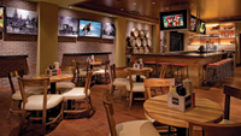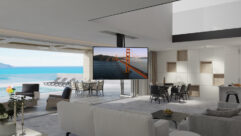
The Buzz: Installation Spotlight: POP Appeal
Jun 3, 2009 12:00 PM,
Staff Report
Wendy’s restaurants, nationwide

For digital menu boards in Wendy’s restaurants nationwide, Wand selected LG Electronics’ M4212C-BA screen based on its image quality and ability to be used in portrait or landscape mode.
Photo courtesy McCarran International Airport
In 2008, the Wendy’s restaurant chain began the process of transitioning from static trans-light menu boards to dynamic digital menu boards in order to modernize many franchise and corporate-owned restaurants. The transition required ongoing digital signage installations in restaurants across the country and needed clear, insightful guidance on what products would work best for Wendy’s applications. This direction came from Eden Prairie, Minn.-based Wand, with the help of the company’s 22 years of experience in the field of quick-service restaurants (QSR) and almost 20 years of business presence with point-of-purchase (POP) systems in more than 1,600 Wendy’s stores.
Digital menu boards are a specialized type of digital signage designed to specifically promote products in the store at the POP. The objective was to combine the visual appeal of television with the substance of printed information, so choosing the right LCD screen was paramount to the process. Against the right backdrop, the information would be tastefully expressed through animation and crisp computer graphics technology.
The transition to digital menu boards had to satisfy four main goals the restaurant chain had for the boards. Those goals included driving greater customer awareness of promotions and specials to increase sales; influencing customer purchasing behavior to promote high-margin items; increasing the frequency of “combo conversion” orders—ordering extras such as a soft drink and fries instead of just a sandwich, or add-on orders such as desserts, chili, or a salad; and lowering perceived wait times to improve customer satisfaction.
Related Links

Technology Showcase: Turnkey Digital Signage Systems
If you want a digital signage system installed soup-to-nuts, most people have traditionally gone to systems integrators or value-added retailers who can consult on their needs, know all the best-of-breed components available, and can oversee the whole installation based on their years of expertise…

Digital Signage Expo Opens Amidst Cautiously Bullish Expectations
The Digital Signage Expo begins Tuesday, Feb. 24, in Las Vegas with a backdrop of bleak economic news, but Chicago-based analyst Chris Connery remains quite bullish on the category.
Digital Signage Update
caught up with Connery, vice president for PC and large-format commercial displays at DisplaySearch, as he was packing for the Feb. 24 to 26 show…

How Digital Signage Can Help in a Tough Economy
Digital signage appears to be substantially insulated from the general cutbacks in spending for technology and advertising. Austin, Texas-based DisplaySearch just released its 2009 forecasts, which predict robust 44 percent growth in unit volume for LCD and plasma screens used for digital signage and large-format commercial display applications…
With these goals in mind, Wand selected LG Electronics’ M4212C-BA screen based on its image quality and ability to be used in portrait or landscape mode. That model also boasts a Super IPS 178-degree viewing angle, which ensures that customers can view the screen from nearly any angle, while an enhanced lifespan in portrait mode makes the screen durable for a busy restaurant environment.
Typically, four screens are being installed in each participating Wendy’s location as digital menu boards in vertical and horizontal configurations, with the option to add two vertical POP screens (also M4212C-BA units). Installed to the sides, these additional units are meant to promote specials. LG’s 38in. Stretch Screen (M3800S-BN) is also being used effectively in some restaurants that have tighter spaces, requiring a slim screen, to promote items such as ice cream treats.
The messages conveyed through the Wand POP system now appear in widescreen high-definition where they have been installed, and that clarity has potential to help patrons make informed selections that satisfy their hunger and drive store revenues. With Wand’s content-deployment strategy, individual store owners can schedule promotions to run on certain days, and for specified periods of time, ensuring equal or greater flexibility than with the older menu boards.
Wand’s wall-mounting technique—which consists of modified Chief Manufacturing mounts—firmly secures the monitors into the wall above the counter in each Wendy’s location using a single bracket for all screens. This allows the units to fit into the spaces previously filled by inanimate plastic signage. Some have even chosen to encase their digital menu boards in modern wooden frames to match the décor of the restaurants.
Over time, the Wand Digital Restaurant solution is expected to completely replace the static menu boards and paper advertising collateral in all Wendy’s restaurants. All digital menu boards in Wendy’s locations are controlled remotely, using Wand’s proprietary Enterprise Manager software to configure and modify pricing and digital content. These modifications may be applied to either a specific site, across a zone, or an entire QSR company or franchise. This is based on a scalable programming architecture built into the Enterprise Manager tool. Content is pushed down from the Enterprise Manager tool, allowing the user to update one, some, or all sites in-network. In addition, sales data from the POP system will be able to serve up realtime test marketing and sales results.
Additionally, the SmartMarketing application promotes Wendy’s hot food when it is cold outside, and encourages cool or cold foods and beverages when the weather is warm, based on what was flagged when the content was created. This allows the digital menu boards to present the temperature, local and/or national news, and points of civic interest—such as an Amber Alert or a Code Adam—to Wendy’s patrons.
Calculating ROI on Wendy’s digital menu boards was initially a difficult proposition. Since the technology generally proved to pay for itself rather quickly (within nine to 18 months), Wand was eventually able to calculate how the “wow” factor combines with the increased store revenue to determine ROI. One hundred percent (or greater) ROI for most stores is usually realized within 15 months of installation, according to officials at Wand.
As a result of these installations, many franchisees have seen double-digit growth in the targeted products they are promoting via their digital menu boards and POP boards. According to Greg Perrill, chief operations officer of Wand, all have reported immensely positive feedback from their customers, who have expressed their enthusiasm, saying that these restaurants have finally entered the 21st century.
The overall digital signage makeover is an ongoing effort in Wendy’s locations across the country, and it has only just begun. However, improving customer satisfaction and reducing perceived wait times, in addition to increased in-store sales, are well worth the time and effort of this technology makeover, Perrill says.









